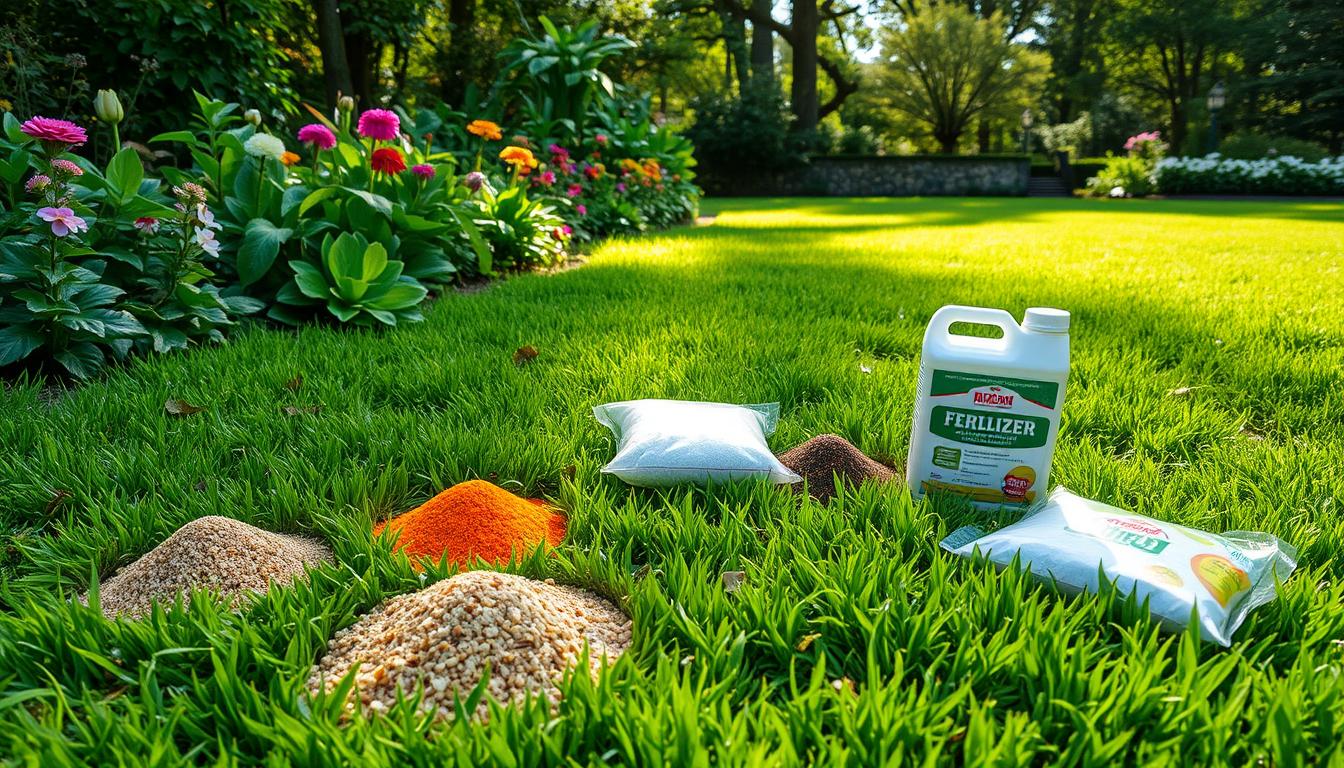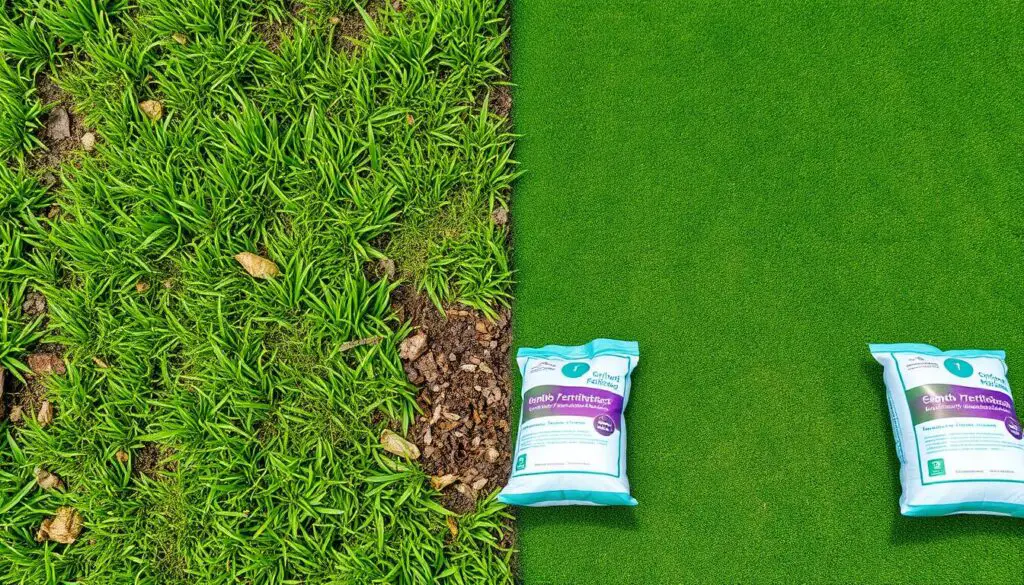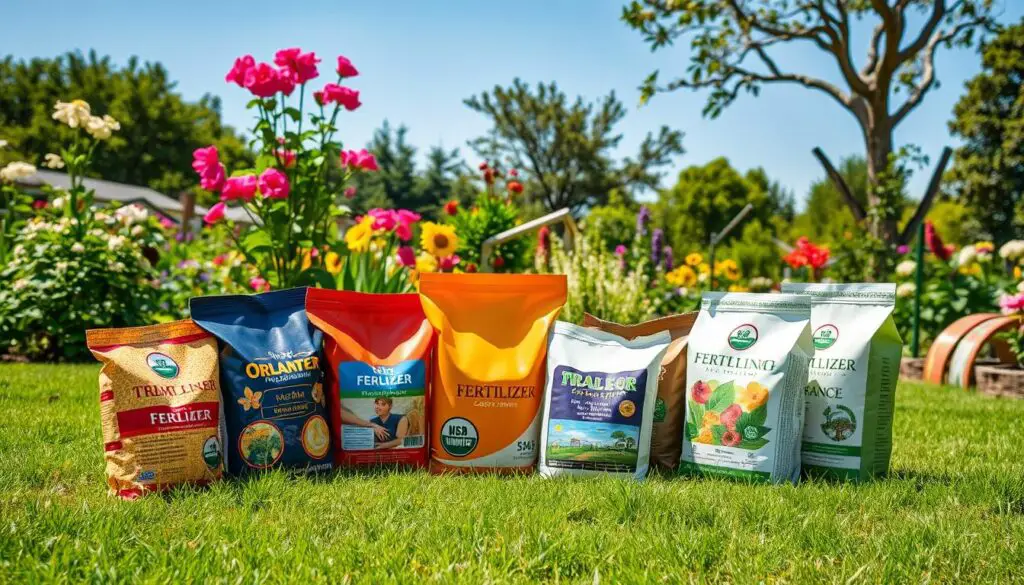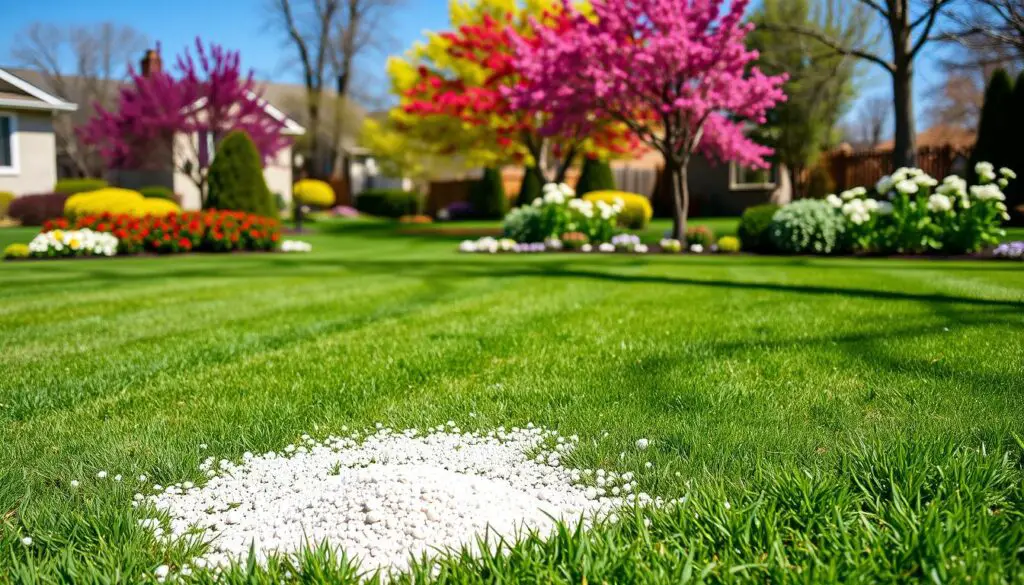How to Choose the Best Lawn Fertilizer

Did you know the average American household spends over $500 a year on lawn care?
This includes fertilizers. With so many choices, picking the right fertilizer can be tough. But, knowing the key factors can help you make a smart choice and get the lawn you’ve always wanted.
As someone who loves gardening, I’ve found that the secret to a great lawn is the NPK ratio. This stands for nitrogen (N), phosphorus (P), and potassium (K).
Each nutrient is crucial for grass growth, root health, and fighting off diseases. By looking at the NPK label and understanding your soil, you can pick the best fertilizer for your lawn.
In this guide, I’ll show you how to choose the best fertilizer for your lawn. We’ll look at the differences between organic and synthetic fertilizers. We’ll also talk about specialty fertilizers for special needs and the best times and ways to apply them. This will keep your lawn looking green and healthy all year.
Key Takeaways
- The NPK ratio on fertilizer labels shows the percentages of nitrogen, phosphorus, and potassium. These are key for a healthy lawn.
- Granular fertilizers cover evenly but are harder to apply. Liquid fertilizers work fast but might cause uneven growth.
- Organic fertilizers are good for the environment but can be pricey. Synthetic fertilizers are cheaper but can harm soil life.
- Specialty fertilizers, like those for new lawns or weed control, meet specific needs.
- When and how you apply fertilizer are important for its effectiveness.
Understanding Fertilizer Labels
Keeping your lawn healthy and green is easier when you know how to read fertilizer labels. The numbers like 10-10-10 or 32-0-10 show the NPK ratio. This tells you the amount of nitrogen, phosphorus, and potassium in the fertilizer. Each nutrient is important for your grass’s growth and health.
Nitrogen (N), Phosphorus (P), and Potassium (K) Ratios
Nitrogen helps your grass grow green and strong. Phosphorus makes the roots grow deeper. Potassium keeps the plant healthy overall. The ratio changes with the seasons to meet your lawn’s needs.
In places like the Intermountain West, fertilizers might have extra nutrients. These include zinc, iron, and manganese. They help with the local soil and climate.
Calculating Nutrient Amounts
The guaranteed analysis on a label shows the nutrient percentages. For example, 18-6-12 means 18% nitrogen, 6% phosphate, and 12% potash. To find out how much you get, multiply the percentage by the bag’s weight. A 50-lb bag of 18-6-12 gives 9 lbs of nitrogen, 1.3 lbs of phosphorus, and 5 lbs of potassium.
By understanding the fertilizer label and calculating the nutrients, you can give your lawn what it needs. This will help your grass stay lush, healthy, and strong all year.
Types of Fertilizers
Granular vs. Liquid Fertilizers
Choosing the right fertilizer is key to a lush lawn. There are two main types: granular and liquid. Each has its own benefits, so it’s crucial to know the differences.
Granular fertilizers are spread with a spreader and release nutrients slowly. This slow release ensures your lawn gets nutrients like nitrogen and potassium steadily. They’re often cheaper and last longer, making them a favorite among homeowners.
Liquid fertilizers work fast, mixing with water and being applied directly to the grass. They’re great for quick results or spot treatments. But, they don’t last as long as granular options.
The right fertilizer for your lawn depends on your grass type, soil, and preferences. Knowing the pros and cons of each type helps you choose the best one for your lawn.
“Granular fertilizers release nutrients slowly, providing long-term benefits, while liquid fertilizers offer a quick green-up for your lawn.” – Sam, lawn specialist
Organic vs. Synthetic Fertilizers
When it comes to fertilizing your lawn, you have two main options: organic and synthetic fertilizers. Both have their own unique advantages and disadvantages. It’s important to understand the differences before deciding which one is right for your needs.
Pros of Organic Fertilizers
- Organically derived fertilizers generally have a lower NPK analysis than synthetic fertilizers, but they feed plants for a longer period of time.
- Organic fertilizers stimulate beneficial soil microorganisms and improve soil structure, which is beneficial for long-term soil health.
- Organic fertilizers provide secondary and micronutrients usually absent in synthetic fertilizers, offering a more comprehensive nutrient profile for your lawn.
- Milorganite®, a pelletized organic fertilizer, contains non-staining iron and is derived from dead microbes, preventing lawn or plant burning.
- Milorganite® is cost-effective, easy to apply, and available in large convenient bags for homeowners.
Pros of Synthetic Fertilizers
- Synthetic fertilizers are fast-acting and come in various forms such as liquid, pellet, granule, and spike, allowing for more flexibility in application.
- Synthetic fertilizers are water-soluble, providing quick nutrient uptake by plants, which can be beneficial for lawns that need a rapid boost.
- Synthetic fertilizers do little to stimulate soil life or improve soil texture in the long term, but they can provide a quick and efficient way to meet the immediate nutrient needs of your lawn.
The choice between organic and synthetic fertilizers depends on your personal preferences, budget, and lawn needs. Both types have their advantages and disadvantages. It’s important to weigh the pros and cons to determine which option is best for you.

“Organic fertilizers are beneficial for soil and turf health but require warmth and moisture for nutrients to break down.” – Richard, ecology professional
Specialty Fertilizers
There are many specialized fertilizers for lawns, beyond the usual types. You can find starter fertilizers, weed-and-feed formulas, and seasonal lawn foods. Each has its own benefits.
Fertilizers for New Lawns
Starter fertilizers are key for new grass. They have more phosphorus to help roots grow strong. This gives your lawn a solid start.
Scotts Turf Builder Starter Food for New Grass makes your lawn 70% thicker and 35% faster-growing than unfed lawns.
Weed-and-feed fertilizers fight weeds and feed your grass. Scotts Turf Builder Weed and Feed controls over 50 weeds while feeding your lawn.
Seasonal lawn fertilizers adjust to your grass’s changing needs. Spring and fall formulas are perfect for cool-season grasses. They give the right nutrients during these times.
| Product | NPK Ratio | Coverage Area |
|---|---|---|
| Scotts Turf Builder Starter Food for New Grass | 32-0-4 | 5,000 sq ft |
| GreenView Fall Fertilizer | 22-0-10 | 5,000 sq ft |
| Scotts Quick-Release Lawn Fertilizer | 27-0-2 | 5,000 sq ft |
| Purely Organics Organic Fertilizer | 6-4-0 | 2,500 sq ft |
| Liquid Lawn Fertilizer | 29-0-3 | 2,000 sq ft |
Knowing about these specialty fertilizers helps you care for your lawn better. It keeps your lawn looking great all year.
Choosing the best lawn fertilizer
Choosing the right lawn fertilizer can seem hard with so many options. But, knowing your grass type, soil, and lawn goals helps. This way, you can pick the best fertilizer for a lush, green lawn.
Nitrogen (N) is key for green, growing grass.
Look for fertilizers with more nitrogen, like Pennington UltraGreen Lawn Fertilizer 30-0-4. It feeds your lawn for up to three months. For new lawns, use a starter fertilizer like Pennington UltraGreen Starter Fertilizer 22-23-4. It has more phosphorus and potassium for roots.
For weeds, use a fertilizer and weed control mix. Pennington UltraGreen Weed & Feed 30-0-4 or UltraGreen Southern Weed & Feed 34-0-4 are good. They kill weeds and feed your grass without phosphorus.
Apply fertilizer when your grass grows most. For cool-season grasses, spring and fall are best. Fertilizing in late summer or early fall prepares your lawn for winter.
| Fertilizer | N-P-K Ratio | Coverage Area | Effective Period |
|---|---|---|---|
| Safer Brand Lawn Restore Natural Fertilizer | 9-0-2 | 5,000 sq. ft. | 2-3 months |
| Scotts Natural Lawn Food | 11-2-2 | 5,000 sq. ft. | 6-8 weeks |
| The Andersons PGF Complete 16-4-8 Fertilizer | 16-4-8 | 10,000 sq. ft. | 4-6 weeks |
| Pennington UltraGreen Weed and Feed | 30-0-4 | 5,000 sq. ft. | 2-3 months |
By matching your lawn’s needs with the right fertilizer, you can get the lawn you dream of. Always follow the label for safe use.

“Fertilizing your lawn is an essential part of maintaining a healthy, vibrant landscape. By choosing the right product, you can ensure your grass thrives and stays lush all season long.” – Sam Masser, lawn specialist
Cool Season vs. Warm Season Grasses
Understanding the difference between cool season and warm season grasses is key for lawn care. These grass types grow differently, need different nutrients, and have unique care schedules. Knowing this helps you fertilize your lawn the best way.
Cool season grasses, like Kentucky Bluegrass, Fescues, Bentgrass, and Ryegrasses, do well in cooler weather. They grow best in spring and fall. In contrast, warm season grasses such as Bermudagrass, St. Augustinegrass, Centipedegrass, Zoysiagrass, and Carpetgrass love hot weather. They are perfect for warmer climates.
Timing your lawn fertilization depends on your grass type. Cool season lawns need fertilizer in fall and spring. Warm season lawns should get it from spring to summer, and sometimes into fall. Fertilizing cool season grasses in summer can harm them and make them more prone to disease.
Overseeding with both cool and warm season grasses can make your lawn lush and strong. But, it’s important to know each grass’s needs. By understanding these differences, you can create a lawn care plan that keeps your grass healthy all year.
When to Fertilize Your Lawn
Timing is key when feeding your lawn. The best times are in the spring and fall, when your grass grows most. Spring fertilization gives your lawn the nutrients for lush growth. Fall applications prepare it for winter.
Spring and Fall Fertilization
Fertilize twice a year for a healthy lawn – in spring and fall. The best temperature for fertilizing is around 55 degrees Fahrenheit. This ensures your lawn absorbs the nutrients well.
- Spring fertilization (late March to early May): This application supplies essential nutrients to kickstart vigorous growth and a vibrant, green appearance.
- Fall fertilization (late September to early November): This feeding helps strengthen the lawn’s root system and prepare it for the upcoming winter dormancy period.
By following this lawn fertilization schedule, your grass gets the nourishment it needs. Different grass types need different fertilizers. So, choose the right spring and fall fertilizers for your seasonal lawn care needs.

“A well-fed lawn is better able to sequester carbon and provide ecological services like rainwater purification and prevention of soil erosion.” – Laura, lawn health enthusiast
How to Fertilize Your Lawn
Choosing the right lawn fertilizer is just the first step. Applying it correctly is key for the best results. You can use broadcast, drop, or handheld spreaders, depending on your lawn’s size and needs. Always use a spreader and follow the instructions to get even coverage.
Application Methods and Tips
For big lawns, a rotary or broadcast spreader is best. They cover more ground efficiently. Drop spreaders are better for smaller areas, giving a precise and even spread. It’s important to spread the fertilizer evenly to avoid soil imbalances.
After applying, water the fertilizer in well. This helps the nutrients get to the grass roots and prevents fertilizer burn. Don’t apply fertilizer before heavy rain, as it can cause nutrients to run off and harm water bodies.
Always wear protective gear like gloves and goggles when using fertilizers. This ensures your lawn gets the right nutrients safely and protects the environment and you.
FAQ
What is the NPK ratio, and how do I interpret it on a lawn fertilizer package?
What are the differences between granular and liquid lawn fertilizers?
What are the pros and cons of organic and synthetic lawn fertilizers?
What are some examples of specialty lawn fertilizers, and when should I use them?
How do I determine the best lawn fertilizer for my grass type and lawn goals?
When is the best time to fertilize my lawn?
How do I properly apply lawn fertilizer for the best results?
Source Links
- https://www.lawnstarter.com/blog/lawn-care-2/how-to-choose-lawn-fertilizer/
- https://www.homedepot.com/c/ab/best-lawn-fertilizer-for-your-yard/9ba683603be9fa5395fab90df6af314
- https://grow.ifa.coop/lawn-care/understanding-fertilizer-numbers
- https://ag.umass.edu/sites/ag.umass.edu/files/fact-sheets/pdf/understanding_fertilizer_label.pdf
- https://www.pennington.com/all-products/fertilizer/resources/fertilizer-labels-what-n-p-k-numbers-mean
- https://www.littlejohnslawns.com/blog/types-of-lawn-fertilizers-a-comprehensive-guide
- https://earthdevelopmentinc.com/how-to-pick-the-right-fertilizer-for-your-lawn/
- https://www.milorganite.com/lawn-care/organic-lawn-care/organic-vs-synthetic
- https://ultralawn.com/posts/the-great-fertilizer-debate-organic-vs-synthetic/
- https://www.thelawnforum.com/threads/should-i-even-use-synthetic-fertilizers-and-if-so-how.24776/
- https://www.thespruce.com/the-best-lawn-fertilizers-5525556

